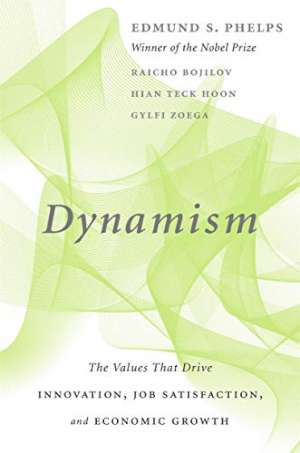26 November 2020
Dynamism:
The Values That Drive Innovation, Job Satisfaction, and Economic Growth
Edmund Phelps, Raicho Bojilov, Hian Teck Hoon, Gylfi Zoega
2020, Harvard, 240 pages,
ISBN 9780674244696
Reviewer: Kevin Gardiner, Rothschild & Co/Cardiff Capital Region Economic Growth Partnership

This is an attempt to test the thesis outlined in an earlier book by Phelps. He argues that among the shortcomings of traditional neoclassical economics is a failure to take into account the non-pecuniary aspects of work, such as job satisfaction, and that this results in a view of economic growth that fails to account for the dynamism of modern economies – specifically, the way in which they innovate.
In his opinion, the “mass flourishing” (the earlier book’s title) represented by the nineteenth century’s surge in prosperity was much more of a bottom-up process than standard accounts suggest. Innovation and progress was, in his view, not just the result of a small number of big breakthroughs in social organisation and technology, but of a more widely-rooted process that reflected the amalgamation of thousands of day-to-day experimentations and improvisations by (relatively) ordinary people. This grassroots driver was in turn, he says, driven by the spread of “modern values” which encouraged people to imagine better ways of doing things in a search for a more fulfilling life – hence the emphasis on job satisfaction.
If so, he argues, conventional accounts of today’s perceived productivity slowdown in developed economies, for example, may be looking in the wrong place.
Unfortunately, the bulk of the book is not as interesting, or as useful to policymakers, managers and investors, as the introductory chapter by Phelps (his only contribution, apart from a short epilogue) suggests.
This may be partly the result of the nature of the thesis itself. Testing such a broad idea is always going to be difficult, and Phelps et al fall into the epistemological trap of claiming that the data are consistent with, or “support”, it. Failing to refute such a loose thesis is not really demonstrating much at all.
Many macroeconomic investigations are really trying to answer compound questions: are the data measuring what we want them to; are their correlations statistically significant; and are those correlations evidence of causality?
The authors’ database on what they call innovation is not as visible as it could be, but seems to rely on identifying step changes in measures of total factor productivity (starting in the late nineteenth century, and ending frustratingly in 2012). Their evidence of job satisfaction (and other qualitative variables) is drawn, inevitably, from surveys. In one chapter they infer general conclusions (about global innovation) from a few interviews with Icelandic technology companies (Steve Jobs’ biography might have been more illuminating). And finally, in the weakest part of the book they fall prey to what I would argue is another of the failings of conventional economic analysis: they spend several chapters translating an unremarkable notion – labour-augmenting “robots” may have a different effect on real wages than labour-replacing “robots” – into mathematics, for reasons known only to themselves and the peers whose reviews are needed for academic credibility.
I am prepared to believe that Phelps’ ideas about dynamism are right, and I share (I think) his values. But we are the very edge of economic knowledge here.
